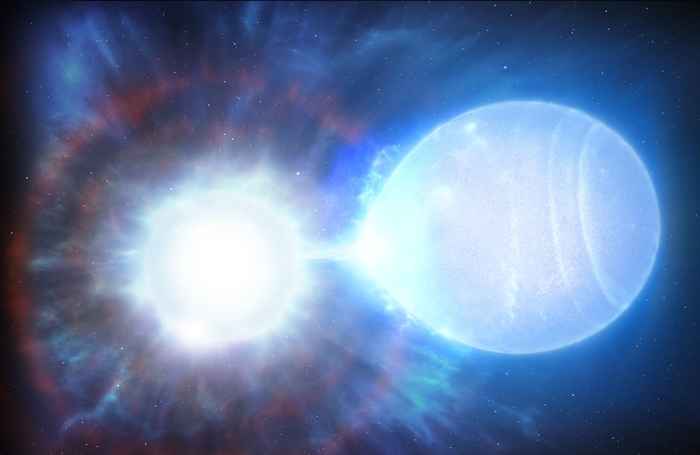Astronomers discover doomed pair of spiralling stars on our cosmic doorstep
4 April 2025

Type 1a supernovae are a special class of cosmic explosion, famously used as ‘standard candles’ to measure distances between Earth and their host galaxies. They occur when a white dwarf (the dense remnant core of a star) accumulates too much mass, is unable to withstand its own gravity, and explodes.
It has long been theoretically predicted that two orbiting white dwarfs are the cause of most type 1a supernova explosions. When in a close orbit, the heavier white dwarf of the pair gradually accumulates material from its partner, which leads to that star (or both stars) exploding.
This discovery, published today in Nature Astronomy, has not only found such a system for the first time, but has found a compact white dwarf pair right on our doorstep in the Milky Way.
James Munday, PhD researcher at Warwick and leader of the investigation said, “For years a local and massive double white dwarf binary has been anticipated, so when I first spotted this system with a very high total mass on our Galactic doorstep, I was immediately excited."
The astronomers used a series of telescopes and a range of data for their research. First, the Gaia satellite provided a list of promising candidates. Then the researchers analyzed the starlight from these candidates using two Dutch-British telescopes on the Spanish island of La Palma: the William Herschel Telescope and the Isaac Newton Telescope. They also used the Nordic Optical Telescope (also on La Palma), the European Very Large Telescope (Chile) and data from space telescope Hubble and from Pan-STARRS in Hawaii.
Co-author Silvia Toonen (University of Amsterdam) has been studying binary stars for years. "More double stars have been seen before, but they never met the right specifications. That we now saw the perfect white double dwarf had to come at some point, but it did take a long time though."
This new system is the heaviest of its type ever confirmed, with a combined mass of 1.56 times that of the Sun and a separation of just 1/60th of the Earth-Sun distance. At this high of a mass, this means that, no matter what, the stars are destined to explode.
The explosion is not due for another 23 billion years, however, and despite being so close to our solar system, this supernova will not endanger our planet.
Right now, the white dwarfs are leisurely spiralling around each other in an orbit taking longer than 14 hours. Over billions of years, gravitational wave radiation will cause the two stars to inspiral until, at the precipice of the supernova event, they will be moving so fast that they complete an orbit in a mere 30 – 40 seconds.
For the supernova event, mass will transfer from one dwarf to the other, resulting in in a rare and complex supernova explosion through a quadruple detonation. The surface of the mass-gaining dwarf detonates where it is accumulating material first, causing its core to explode second. This ejects material in all directions, colliding with the other white dwarf, causing the process to repeat for a third and fourth detonation.
The explosions will completely destroy the entire system, with energy levels a thousand trillion trillion times that of the most powerful nuclear bomb.
Billions of years into the future, this supernova will appear as a very intense point of light in the night sky. It will make some of the brightest objects look faint in comparison, appearing up to ten-times brighter than the moon and 200,000 times brighter than Jupiter.
More details can be found in the full Nature Astronomy publication: DOI: 10.1038/s41550-025-02528-4